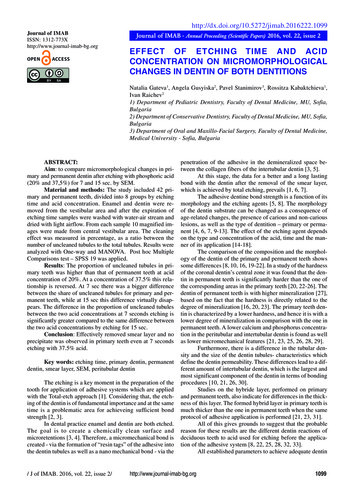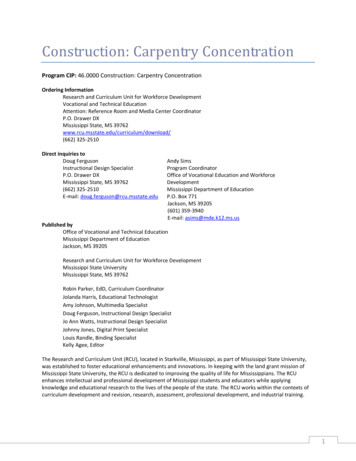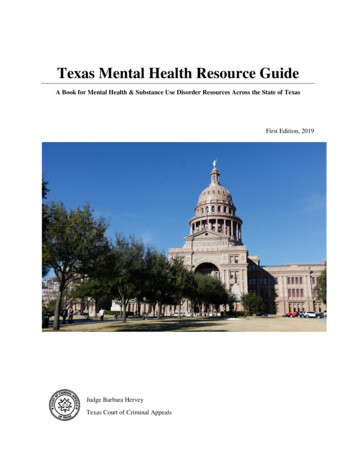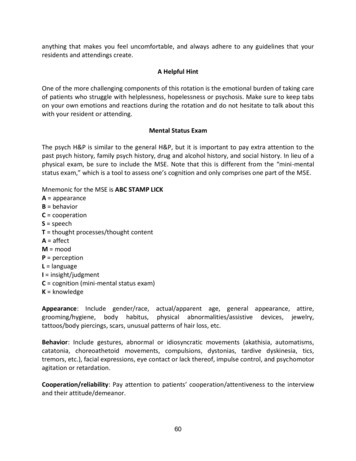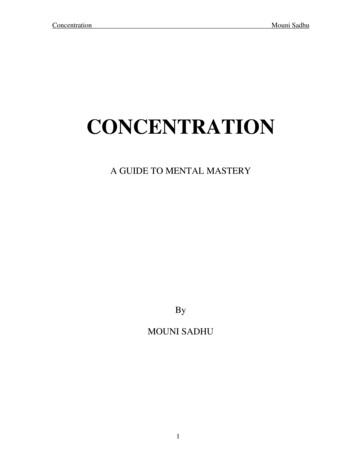
Transcription
ConcentrationMouni SadhuCONCENTRATIONA GUIDE TO MENTAL MASTERYByMOUNI SADHU1
ConcentrationMouni SadhuTo my unforgettable GuruAnd his true disciplesThis book is dedicated2
ConcentrationMouni SadhuPREFACEThis book has been written to bridge the gap between the many existing theoretical workson mental concentration and meditation, and the general application of the mind’s powersto everyday life.The extensive literature on these subjects provides plenty of “commandments” as to whatshould and should not be done and when to develop control of the mind. But it is not easyto find the most important and essential advice which concerns the practical answers to theunavoidable questions “How?” and “Why?”More than half a century ago a gifted and experienced American—William WalkerAtkinson, writing under the pen name of Yogi Ramacharaka, published a series of veryuseful books on Eastern philosophy and Yoga, which were wisely and purposefully basedon his “Eclectic Method.”His main works are Hatha Yoga, Raja Yoga, Gnani Yoga, Fourteen Lessons in YogiPhilosophy and Oriental Occultism, and his final message under the title of Philosophiesand Religions of India. These are perhaps the best of their kind and are unique, filled withpractical advice.He selected the best material he could find from the various known scriptures of his day,without any Corresponding effort on the part of other contemporary occultists.In the second half of this century, great advances have al ready been made in psychology ingeneral as well as in occult psychology, and today we know far more about the humanmind and its workings than did our forefathers.Today, details may alter in the methods of dealing with man’s main motive power—hismind; but the fulcrum of this present study remains unchanged.The writer has impartially tried to collect in this book the best and most tested methods andexercises, plus all necessary explanations, which later may give the student a basis for hisown deliberations, by revealing previously unperceived horizons. In particular, it is hopedthat the exercises in Part III will serve this purpose.This work may prove useful for two types of readers:1. The near agnostic who wants to rule his mental powers for the improvement of his statusand circumstances. For him, only portions of the book will be of interest, namely thepractical exercises in Part III together with the explanatory chapters of Parts I and II. Hehas no need to go beyond the seven double exercises—Nos 1 to 7A.2. The seeker of things deeper than his own temporary physical appearance, who will findit necessary to study the book as a whole with special attention to the explanatory chaptersin Parts I and II, and the culminating ones in Part IV treating the final conclusions of supermental achievement. This is guided intuitional knowledge, also called the wisdom of theSelf, which is the ultimate aim of concentration.In the beginning, no particular creed is required of either type of student. The ability toreason soundly is the foremost condition for success. Such an ability will be developed intoa higher power of cognition by using, as a base, its sharpened tool—the perfectly controlledmind, which will then begin to reflect the reality of man’s ultimate essence, the immortaland illimitable spirit.This book is not limited to any particular system of philosophy and its techniques, andmaterial has been freely drawn, according to its value, from both our Western and Easternin heritance.3
ConcentrationMouni SadhuThe author, throughout a lifetime of searching, has found that there are few things knownto the highest circle of advanced Easterners which are not known to their Westerncounterparts, and vice versa, providing these men are earnest enough and endowed with therequisite abilities and qualities. The outer forms of the Eastern and Western traditions maydiffer, but not their innermost initiatory contents.4
ConcentrationMouni SadhuIForeword and DefinitionsThe Latin origin of the English word “concentration” has a clear and definite meaning. Itrefers to that which has a common center, or is moving toward a center, and is bestexpressed by the term “one-pointedness,” which, etymologically, is not far from the literalsense of the Latin.In this study I will try to show, in a purely practical way, how the human mind can beconcentrated in order to gain the ability of one-pointedness. The necessary psychologicaland technical explanations will be kept to the minimum essential to enable the student tostart his exercises with a reasonably clear understanding of what he is doing and why.“Why, When and How should a study of concentration be undertaken?” and “What is to beattained if the study proves successful?”Imagine that you have an unsharpened pencil or a small stick. If you have to use either ofthem to pierce a piece of cardboard, you will find it difficult until the ends of your simpleimplements have been properly sharpened. Even considerable pressure exerted on anunsharpened pencil will not produce a neat hole. Why? Because a simple physical law is atwork. Your power has been dissipated over the whole, comparatively large surface of theblunt instrument, thus providing insufficient force to separate and remove the particles ofcard board and form a clean hole.Similarly, a blunt knife or saw does not cut well and the result is unsatisfactory since theeffort is wasted by being spread over too large an area and too many points. It is notconcentrated.But sharpen your tools and there will be no difficulty in piercing a hole or cutting a straightline. Where then lies the secret, if any? Merely in the fact that force applied through asingle point acts more effectively and seems far greater than the same force simultaneouslyexerted on many points. This elementary law should be clearly and strongly established inthe mind of anyone studying concentration. It is the justification for all the exercises thatfollow in Part III of this book.Here we are not seeking to perfect a physical tool. The proper employment of the mind isour first aim—the mysterious power and attainment which can be gained only by use of awell-sharpened, one-pointed tool. With regard to the human mind we may call this the“thinking principle.”At this point I would like to quote from the sayings of the most recent of the great Indianrishis (or sages)—Sri Ramana Maharshi, who was an authority on occult psychology andall questions pertaining to the human mind:“An average man’s mind is filled with countless thoughts, and therefore each individualone is extremely weak. When, in place of these many useless thoughts, there appears onlyone, it is a power in itself and has a wide influence.”We know that many great scientists and inventors, whose ideas are now serving humanity,often ascribed their unique discoveries to just this capacity for strong, concentratedthinking. This was the case with Isaac Newton, Thomas Alva Edison, Louis Pasteur andmany others, all of whom were conscious of and able to use their extraordinary powers of5
ConcentrationMouni Sadhuconcentration, i.e., the ability to think solely about the object of their investigation to theexclusion of all else.In Latin America, people who are unable to control their minds and forever wander fromone thought to another are jokingly, but very appropriately referred to as having“quinhentos pensamentos” — “five hundred thoughts”—at one time.The idea of sharpening or concentrating our minds is neither new nor illogical, but ratherscientific, since it has definite means and aims which can be thoroughly investigated,applied and reached.6
ConcentrationMouni SadhuIIThe MethodAny secondhand treatment of this subject will be of little use to students who really want toget positive results from their efforts. So, in this book, I have systematically gatheredtogether a number of practical exercises, all of which have been used and tested as regardstheir effectiveness.Some of them may already be familiar to occultists who have long been engaged in thestudy of concentration. Some have been developed by the writer himself, while others weretaken years ago from sources now no longer available, as the authors are long since deadand their books have disappeared. These latter exercises are the work of the mostauthoritative and competent exponents, but nevertheless they have all been chosenaccording to one standard-tested proof of their usefulness and safety.The worst that can happen to a student lacking the will power to fulfill exactly all theinstructions as prescribed, is no attainment and no results.This will undoubtedly be the lot of anyone who attempts to reap the fruits of concentrationpurely for his own egoistic and material aims; for concentration is not the final target. It isonly a necessary ability and tool which allows a man a higher and better level of lifeconsciousness, otherwise unattainable by laymen in this particular subdivision of occulttraining.The method adopted here is based on a strict grading of sequence of the student’s steps.The exercises themselves have been limited in number to the absolutely indispensableminimum. This is very important, as every change gives rise to some fluctuations withinthe mind, and this should be avoided as far as possible. But not even the smallest detailshould be omitted from the exercises, because the success of the endeavor depends uponthe exactness of their application.The beginner may know nothing at all about the method facing him and he is stronglyadvised not to read in advance any of the chapters beyond those on which he is working,especially the advanced ones (Chapter XVIII and XIX), until all the preceding ones havebeen mastered. This will be your first small showdown with the rebellious and selfishmind. There are very many instances where people have spoiled their work andextinguished their enthusiasm by unnecessary curiosity, which is only harmful anddestructive.Why not ask your mind here and now, “Which of you is boss?”Instead of concentrating the mind, reading in advance will only create additional burdens todistract an earnest student who is working for really positive results. And there are quiteenough obstacles to overcome and troubles to avoid without adding to them. Curiosity isthe true creator of problems and by yielding to that vice how can we expect to acquire theopposite virtue, which is peace of mind?This does not mean that we should completely abandon thinking with our present, more orless developed minds. That would be ridiculous and is not at all what I mean. What we arefighting for in this work is our inner freedom and balance, and the inescapable—but howwelcome—mysterious, inner, but most real knowledge. It is the fulcrum on which will restyour whole inner world, and this is the only thing which a man can take with him into7
ConcentrationMouni SadhuEternity, no matter in what forms or worlds he may continue to manifest himself. It isessential that you curb the excessive curiosity of your mind for at least the short periodswhen you are working for perennial instead of mortal and ephemeral things. Do you notagree that these half-hours or so should be free from the slavery in which you are at presentheld by your uncontrolled and unruly mind? Its conquest will yield you something which,once gained, may end all the deeper questions of your life.8
ConcentrationMouni SadhuIIIThe Use of ConcentrationThe power of concentrated thinking as applied to everyday life is very well known andwidely recognized. It does not need any proof or special explanation. But the average mandoes not use even a fraction of that power properly. If the reader disagrees with this, then Iwould like him to explain to me, or better to himself, if he knows why he is thinking in aparticular way and not in another. Why some thoughts come to him, no matter whether ornot he “invited” them. And if he can foretell what things he will be thinking about a fewminutes hence. Can he really of his own will close his mind to an annoying or obsessingthought? Where do his thoughts actually come from?If these questions remain unanswered, then we have to recognize that we are not masters ofour minds. To put an end to this far from desirable condition is one of the first and foremostaims of this study of concentration.Control of a machine means that we are able to put it into action, modify its speed andfinally to stop it when needed.This is just what is required of a disciplined mind.True concentration is not merely an ability to direct and maintain our full and exclusiveattention for some minutes on, say, a pinhead; but rather it is the ability to stop the thinkingmachine and look at it when it has ceased revolving. A craftsman feels sure that his handswill obey him and execute the exact movements he requires. Indeed, he does not even thinkabout it and works without worrying whether or not his hands will do just what he wants ata given moment. Under such conditions hands and other human organs, when workingproperly, constitute a harmonious unit, capable of functioning in their own particularsphere of action.Imagine now that some part of your body refuses to obey the impulses issued from thecontrol center of your brain. For example, instead of pouring a glass of water when you arethirsty, your hand lights a cigarette or even refuses to move at all. Surely you will considerthat such a hand is of little use.Now look closely at the functions of your mind-brain. Can you affirm with utter certaintythat you always think only when and about what you really want to, and that therefore youknow from where your thoughts and feelings come into the light of your consciousness?Can you withhold the entry or limit the duration of thoughts in your mind for as long asyou wish? If you are able to analyze your thinking processes, your honest answer will be inthe negative.So it would seem that the average man is not a good craftsman, because he cannot controlhis chief tool—th
A GUIDE TO MENTAL MASTERY By MOUNI SADHU . Concentration Mouni Sadhu 2 To my unforgettable Guru And his true disciples This book is dedicated . Concentration Mouni Sadhu 3 PREFACE This book has been written to bridge the gap between the many existing theoretical works on mental concentration and meditation, and the general application of the mind’s powers to everyday File Size: 389KBPage Count: 116
